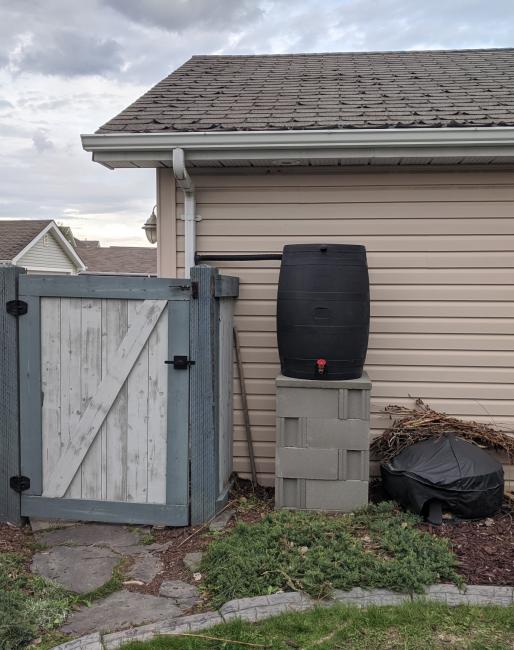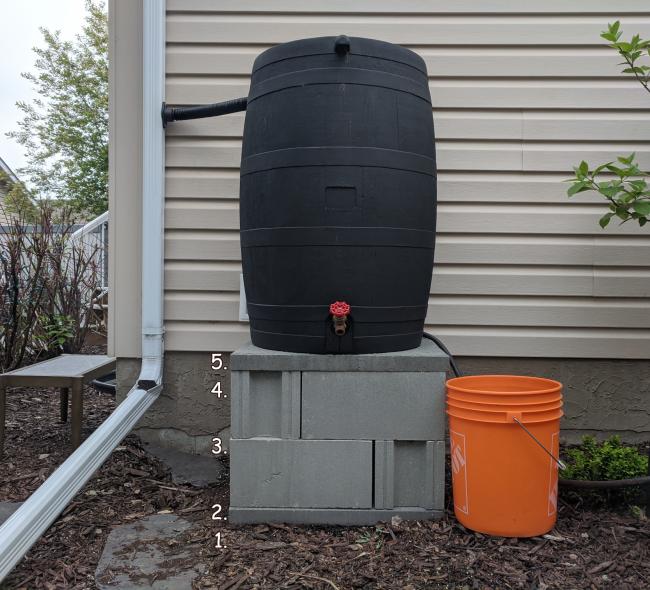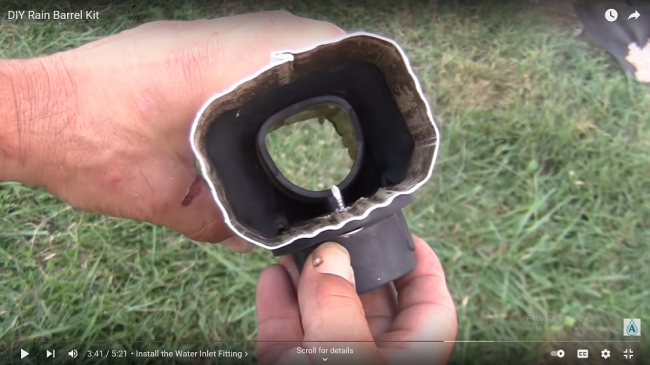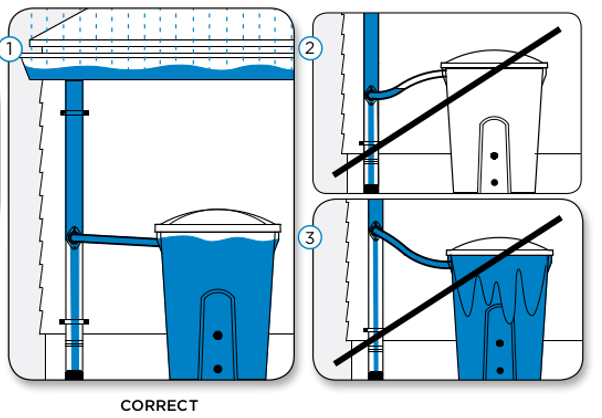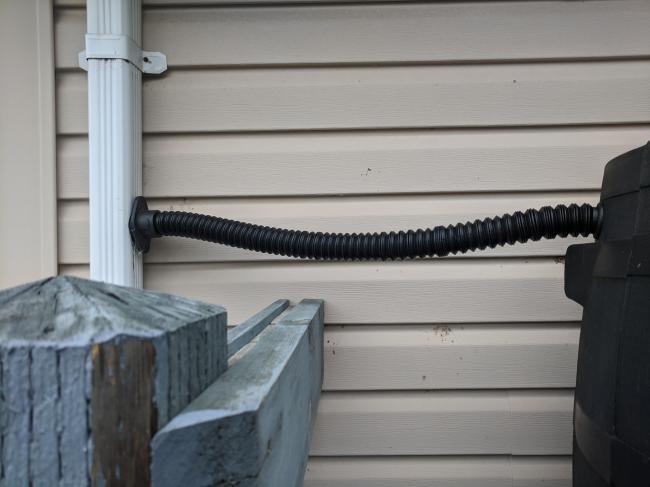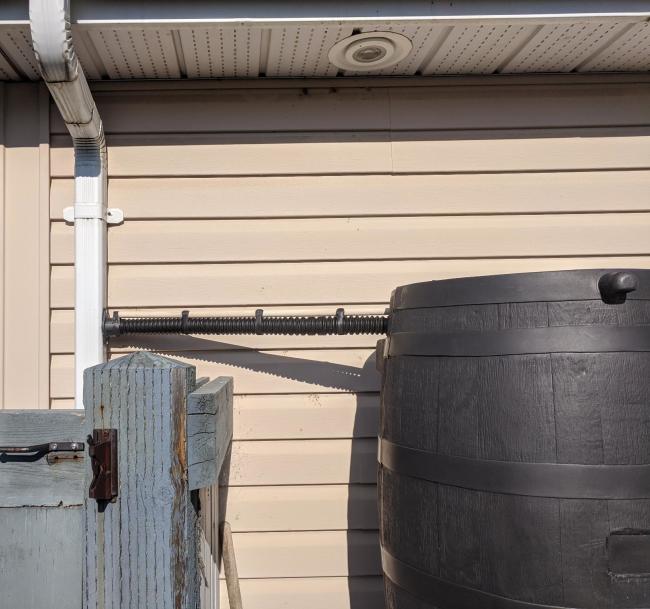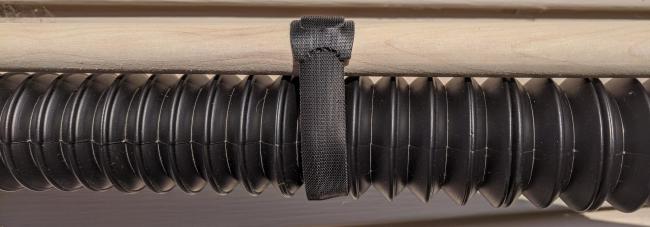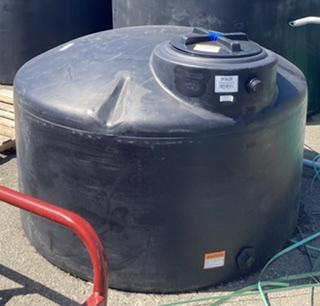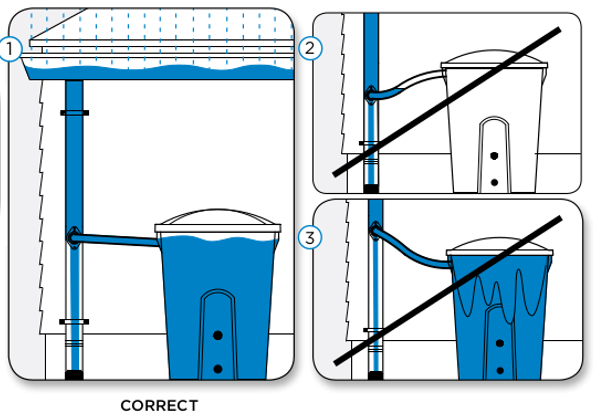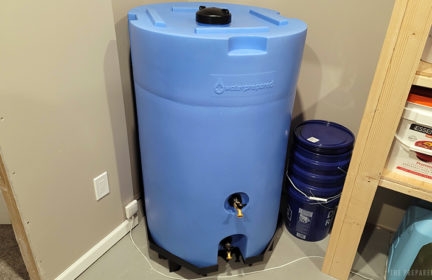DIY Project: Rain barrel water collector
If you have a roof, and it rains, you can collect and store rain water to improve your resilience. Having extra water increases your drought tolerance, extends your watering window, and may even save you some money.
Note: This assumes you already have gutters and downspouts connected to your roof, to move the water away. If not you will need to set those up first, which is big enough to be its own project.
Where Rain Water Collection Is Legal
Strangely, some countries allow collection of rainwater, and some do not. Check your country or local laws to confirm, before you begin. I collected a list of links and countries at the end of this article; updates or additional sources are welcome.
Tools You Need
- A drill
- A level
- A pencil
- Safety goggles
How To Do It
You will need a rain barrel, a sturdy base to stand it on, and a diverter to get the water from the downspout into the barrel. The diverter is the trickiest part, but I’ve done the research so you don’t have to.
The Barrel
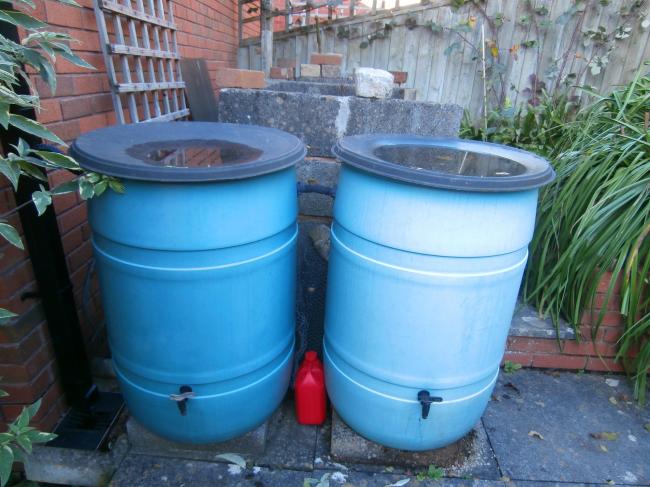
You want a food grade barrel. Depending on your goals and budget, you can often find these for free on craigslist or from local restaurants and food supply stores. You can also buy them at hardware stores. Some cities and counties have water barrel programs where they may give away or sell you barrels at a discounted rate. Check your local water utility.
I sourced a free barrel from a neighbour but it was not opaque. I wanted an opaque barrel so no light would get through to reduce algae growth. I ended up buying one from the hardware store.
A Closed Top
I prefer a barrel with a closed top, so mosquitos and critters can’t get in and breed or drown. Some barrels come with hatches. I assembled a hatch cover using some plastic and some old landscaping cloth, to keep sunlight out.
The Base
One gallon of water weighs 8.3 pounds or 3.7 kilograms. A 55 gallon barrel of water weighs 460 pounds, or 208kg. You need a sturdy base to hold this weight.
I used the following layers as a base:
- Sand on the ground, below the base. Make sure this is level before you start.
- 24” square cement pad. These might be called “paving stones” or similar names, depending on where you get them.
- Four standard cement blocks. These measure 8” bx 8” by 16”, so if you fit them into an “L” pattern you can put an 8” side and 16” side together to perfectly cover the 24” pad.
- A second layer of cement blocks to raise the barrel up. This increases the water pressure, and is tall enough that you can fit a standard 5-gallon bucket under the tap
- A second 24” cement pad on top
Make sure your base is level again, then set everything into place.
The Diverter
The diverter moves the water from the downspout into your rain barrel.
I spent thirty hours researching eleven different models of downspout diverters. In the end I chose the EarthMinded FlexiFit diverter.
I chose this diverter model because:
- You only need to cut one small hole in the side of your downspout
- You do *not* need to sever the entire downspout. So if the project does not work out, you can simply plug up the hole (plug included) and move on
- The diverter fits many sizes of downspout. Depending on where you live, your downspouts may be square, round, rectangular, and many different sizes -2”x3” , 3”x4”, round 3 to 6”, K-style, etc. The EarthMinded diverter is made of flexible, UV-resistant rubber (EPDM) so it can change shape to accommodate your downspout. Even if it doesn’t fit exactly it can still collect *some* water. They do also sell a round model for round downspouts.
- The diverter automatically handles overflow, so you don’t need to do anything. When the barrel is full, water flows back up the attachment hose to the top of the diverter. Any more rainwater then simply continues on through a hole in the diverter and down the spout. You don’t need to worry or adjust anything when it rains or stops raining.
- The water barrel system stays closed. Because the water flows in from the side, you can use a closed top barrel. This keeps out mosquitos, keeps out sunlight so algae doesn’t grow, and keeps animals from crawling into your barrel.
I prefer to buy from the company themselves, but you can also sometimes find this diverter at big box stores or hardware stores.
The EarthMinded installation video is pretty clear. Around 3:38 you can see how the diverter fits into the downspout. Because of surface tension, rain running into a downspout clings to the inside edges of the material. This diverter collects water nicely and funnels it into the connecting hose.
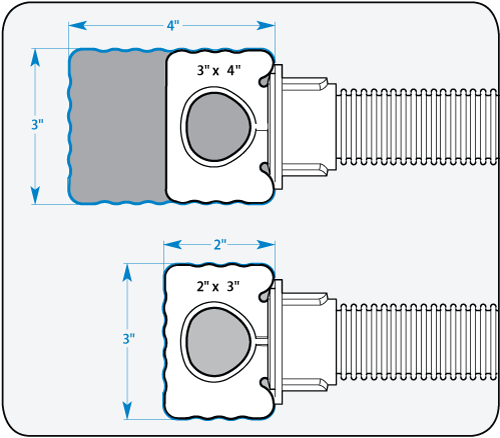
Screen shot of EarthMinded diverter in cross-section of downspout – from their installation video.
Setting It Up
Now that you have all of your parts the procedure is fairly easy.
- Assemble your base, and put the water barrel on top.
- Make sure the connecting hose can reach from the downspout to the barrel.
- The important part is: make sure that the hole in the downspout is lower than the highest water level of the barrel. This is what makes the diverter work. If the hole in the downspout is lower than the top of the barrel, then once the barrel is full, water will push back into the connector hose and down the downspout, to continue away on its journey. If you attach to the downspout too high or too low, this won’t work. See the image below.
- With your barrel in place, use your level to mark where the diverter should go, and where to drill the hole. If you have a short level, you can use a 2×4 or wooden board to help measure.
Image from the manufacturer instructions. The diverter hole in the downspout must be cut _below the highest water line_ of the water barrel. This ensures that water will flow back down the connector hose, and into the downspout, once the barrel is full. e.g. If your barrel has a hole in the top or front, the downspout must be installed at a level _below_ those holes.
The EarthMinded kit comes with three circular saw blades for your drill – these are the sizes needed for the tap at the bottom of the barrel (small), the connector hose in the barrel (medium), and the diverter in the downspout (large).
I like to drill the hole for the connector hose in the barrel first, about 2-3” from the top of the barrel. Then place the barrel on the stand and measure a level connection for the hose. This tells me where to drill into the downspout.
Once you have drilled your hole, connect it up. If you have a garden hose you can test the diverter works by spraying water onto the roof.
How Much Water Will You Get?
You need to know:
- How big is your roof?
- How much rain do you get each month?
One inch of rain on 1,000 square feet of roof collects 623 gallons of water. That’s enough water to fill more than 11, fifty-five gallon barrels. The pitch of the roof doesn’t matter. So multiply your roof’s square footage by 0.623 – that’s how many gallons you will get from one inch of rain.
In metric: one millimeter of rain on one square meter of roof collects one Litre of water.
Rainwater collection calculator here: https://www.watercache.com/resources/rainwater-collection-calculator
I have to put my barrel away during winter, so I only count rain received during the summer months.
If you have multiple downspouts, choose which one(s) you will use to install a barrel. Consider whether you want the biggest roof area, the closest spout to your garden or where you will use the water, or other needs.
How Many Barrels Do You Need?
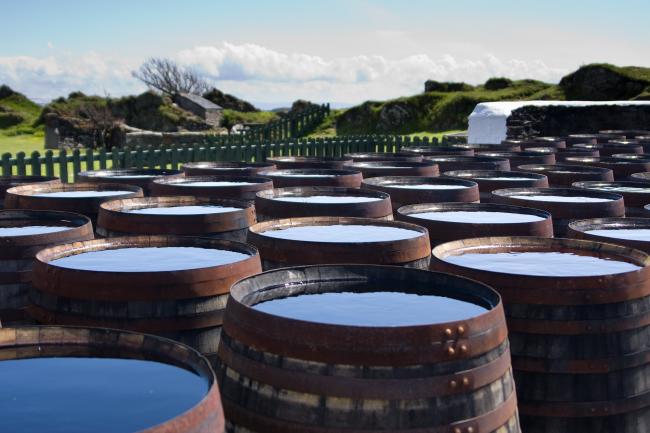
One way to estimate how much water you might use is to calculate 0.5 gallons per square foot of garden space, per week.
Another strategy is simply to look at the space you have and how many barrels you could fit.
Starting with just one barrel is a fine plan. Use it for a season and track your use. How often do you empty the barrel? How often does it rain before you use all of the water? You can decide whether you need more barrels in more locations.
What Can You Use It For?
You shouldn’t normally drink rain water that has been collected into a barrel without properly filtering, cleaning, and processing it first. Main non-potable uses include watering your garden, watering trees or perennial fruit, or flushing toilets.
Return On Investment (ROI)
So how well does a water barrel pay for itself? The biggest factor will depend on where you get your barrel. If you find a free barrel from a local restaurant versus paying $200 for a fancy barrel from a big box store, that will obviously affect your ROI.
Based on rough pricing and some rounding, I find the following costs for these materials:
- Barrel: $0 to $150, depending
- Cement pads: $15 each * 2 pads = $30
- Standard cement blocks: $5 each * 8 blocks = $40
- Water diverter kit: $50 with shipping
That gives a base cost of $30 + $40 + $50 = $120, plus what you spend for the barrel.
You will also need to know how much you pay for water. In many places if you are on metered city water they charge you not only for the water you use, but also a “drainage fee”; so you are charged two amounts for the same water. All the more reason to install these barrels!
All-in-all – In my area with my roof sizes, yearly rainfall, and price for water, a rain barrel should save me $20 to $30 per summer in reduced water use. At a cost of $120 for the base, this means the project pays for itself in 4 to 6 years. If you pay another $120 for the barrel itself, the project pays itself back in 8 to 12 years.
Personally I am happy with a 6 year return on investment that extends my drought tolerance and allows me to make good use of a free resource that would otherwise flow away. If the price of water goes up in your area, this would pay for itself even sooner. And if you are counting on this water to water your garden, water perennial food or fruit, or serve activities like flushing toilets during water restrictions, it is even more valuable. You will have to decide how much peace-of-mind and improved water security is worth for yourself.
I would love to hear about your rain barrel project!
(edit after posting: Corrected bad wording about “being level”. The important part of setup is not to “make sure the connector hose is level”, but rather: ensure the connector hose attaches to the downspout at a level *lower* than the highest water mark / highest water line of the rain barrel. This is what makes the water stop filling the barrel, and begin to backflow into the downspout, continuing on its journey. Thank you to community member Robert Larson for the questions and help identifying this incorrect phrasing.)
—
More Info
- Demystifying Diverters – info on how downspout diverters work, and related topics
- Rainwater Harvesting Calculator
- US Climate & Rainfall Data
- World Water Reserve – more info on diverters
Laws On Rain Water Collection
- Collection assessment – Australia, Brazil, China, Germany, and Singapore all allow and encourage collecting and using rain water.
- United States – collection laws by state
- The UK, collecting rain water is legal so long as it is kept separate from main drinking water
- Canada (link to PDF) – legal to capture for use flushing toilets and surface irrigation
- Japan – encouraged in many areas, with subsidies available
- Belgium (source1, source2) – Rights to using and collecting water protected in the Constitution, with no legal requirement to connect your home to the local water distribution network. Many municipalities offer rebates for installing rainwater collection tanks.
-
Best Replies
-
Comments (17)
-
